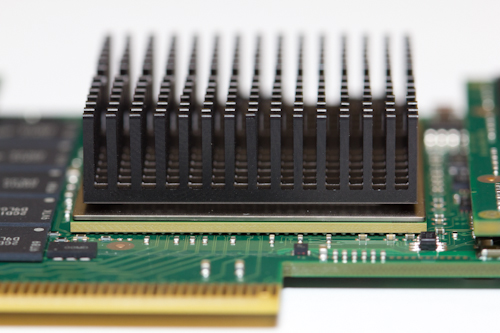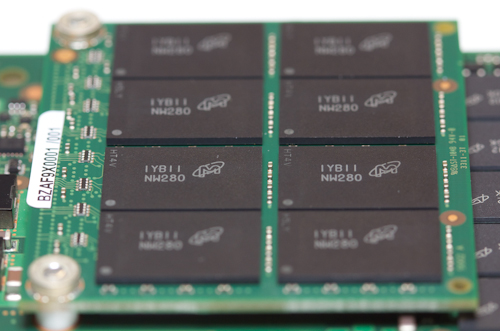Micron RealSSD P320h Review: A PCIe Drive Capable Of 3.2 GB/s
Announced earlier this year, Micron's RealSSD P320h PCI Express-based SSD promises to be an enterprise workhorse. A custom controller, single-level cell NAND, amazingly low latency, stellar random I/O, and incredible endurance combine to blow us away.
Micron's 32-Channel Controller Simplifies PCIe-Based SSDs
Micron set out to simplify PCI Express-based SSDs with its P320h. But before we can understand how the company does this, let's first have a look at a more conventional layout. The image below corresponds to Intel's SSD 910.
Starting from the PCI Express connector on the left, you have a RAID/HBA chip attached to a number of SAS- or SATA-enabled controllers. Those controllers, in turn, communicate with the NAND. In essence, you're taking a number of SSDs (in the example above, four), hooking them up to a host bus adapter, and presenting them as a single device.
In contrast, the P320h consists of a PCI Express interface, a host controller with the ability to communicate over PCI Express built-in, and the flash memory. When you take the HBA out of the equation, you alleviate bandwidth limitations and minimize latency.
Clearly, that custom ASIC is responsible for enabling Micron's design. The company partnered with IDT (Integrated Device Technology) to develop the P320h's controller, combining its extensive knowledge of NAND with IDT's leadership in high-speed serial switching. The result is a 32-channel (!) controller built into a 1517-pin FCBGA (Flip Chip Ball Grid Array) package.
Let that sink in for a second. Most of the controllers you find in SATA-based SSDs communicate across eight channels. It makes sense, then, that it'd take a quartet of "eight-channel SSDs" on a PCI Express-based add-in card to saturate the interface. Micron makes it very clear that its P320h loves workloads that push high queue depths, and we can see the drive's controller was designed to shoulder those intense environments. As a matter of fact, company representatives recommended that we test using queue depths at least as high as 256.
As any hardware geek can tell you, there's something about a bare circuit board that begs for examination, and the P320h's layout is incredibly clean. This half-height, half-length (HHHL) PCI Express 2.1 card is about as elegant as it gets, consisting of the passively-cooled controller flanked by NAND flash and DDR3 cache.
The Micron/IDT controller sits front and center. Immediately to its left are five Micron 256 MB DDR3-1333 memory packages, with another four around back, totaling 2.25 GB of cache. Additionally, the PCB hosts 32 NAND packages, each with 16 GB of Micron's 34 nm ONFi 2.1 single-level cell memory. There is also a pair of double-sided mezzanine boards, adding 32 more packages. All told, the 700 GB RealSSD P320h hosts 1 TB of SLC NAND.
Get Tom's Hardware's best news and in-depth reviews, straight to your inbox.
The 32-channel controller, the 2.25 GB of cache, and the 1 TB of SLC memory should all be clear indicators that this thing is an enterprise-class piece of equipment designed for enterprise-class workloads. Fortunately, we have some of those to throw at it.
Current page: Micron's 32-Channel Controller Simplifies PCIe-Based SSDs
Prev Page Meet Micron's P320h PCI Express-Based SSD Next Page Micron's Firmware And Monitoring Software-
mayankleoboy1 i dont see this as the future of consumer SSD's, just like a 16 core CPU is not the future of consumer CPU's.Reply -
bawchicawawa mayankleoboy1i dont see this as the future of consumer SSD's, just like a 16 core CPU is not the future of consumer CPU's.Reply
Such an apples to oranges comparison... -
memadmax Eliminating the SAS controller is the logical way to have these pci-e based ssd drives...Reply
Kinda surprised something like this didn't come out first as it makes more sense.... -
mayankleoboy1 bawchicawawaSuch an apples to oranges comparison...Reply
really ? Increasingly, performance is basically dependent on extracting parallelism. Whether in storage or in CPU performance.
Desktop/Mainstream users just dont do so much in parallel that they can fully use all the hardware. -
JOSHSKORN mayankleoboy1i dont see this as the future of consumer SSD's, just like a 16 core CPU is not the future of consumer CPU's.I see a purpose for 16 core processors. How are we going to otherwise be able to run Crysis 6?Reply -
mayankleoboy1 JOSHSKORNI see a purpose for 16 core processors. How are we going to otherwise be able to run Crysis 6?Reply
Use a 5000 core GPU ? -
youssef 2010 ArticleAlthough read performance is out of this world, the RealSSD P320h's write performance isn't nearly as spectacular. That's not to say the drive doesn't do well; it's just not as impressive after looking at those massive read numbers. read performance was out of this world, the write performance wasn't nearly as spectacular. Now, that's not to say that the P320h doesn't perform well, it's just not as impressive as the read resultsReply
????????!!!!!!!!!!! -
abbadon_34 After all these years it's nice to see the OCZ Revo at least mentioned. Considering a bootable PCI-E x4 SSD can be had for under $200 for over 5 years now, and is on it's 4th+ generation, one can only wonder why it's been ignored for so long.Reply -
Marcus52 Micron deserves a pat on the back for this one!Reply
Thanks for the review, love to see this kind of advancement and a peak into the future new hardware brings with it, even if it isn't directly applicable to me at this point in time.




